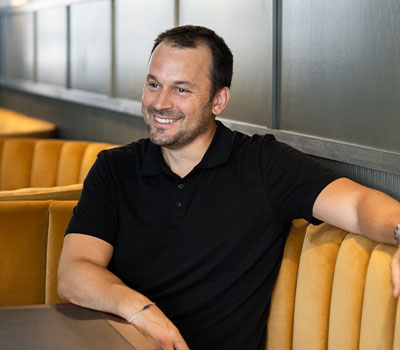After running several restaurants in Ithaca, New York, Cedric Nicaise was looking for a new direction. It was 2008 and the economy was tanking. He needed a marketable skill, so, he started taking classes at the American Sommelier Association. That’s when he got his first sommelier gig at NYC’s Auriole. His talents eventually led him to the role of wine director at Eleven Madison Park, where he worked with executive sous chef Andrew Quinn. The two decided to launch their own place, The Noortwyck, in 2022, in a West Village spot on Seventh Avenue. Nicaise says his personal wine interests continue to parallel what he likes to feature on his wine list: Burgundy, the Northern Rhône and Champagne. —Joshua Greene


• On Burgundy
I think wine lists are self-fulfilling prophecies. If you stock the list longer, that’s what people buy, especially if you can manage to have the right price points in addition to those wines. And so yeah, I think Burgundy sells a lot in all categories. From Bourgogne Blanc to Savigny Les Beaune and Hautes Cotes. We sell sort of everywhere.
In white Burgundy, it’s getting into the upper reaches of the world, but I really like Henri Germain wines from Meursault. They really show tremendous value. They’re hard to get, but I try to keep them on the list at all times.
We sold quite a bit of the Bourgogne Blanc from Pierre Girardin. And I think, again, to me it’s about finding something that is a good value for its price point: It sells for around a hundred dollars on the wine list, and I think provides really good value at that price point.
• On Rhône and Champagne
In the northern Rhône, there are three that I have had the most personal experiences with. It’s really bougie: Chave, Jamet and Gonon. For Chave, a favorite is the regular Hermitage. And then in the more attainable world, I think the Monier Perréol wines are super undervalued and undiscovered. We sell a lot of the Saint-Joseph. And that’s a winery that I’ve championed a long time.
In Champagne, there are so many great fancy producers that everyone loves and that are easy to name. Again, for me it’s about personal experience. I love the J. Lassalle wines—the Rosé, the Cuvée Angeline, is my favorite. And we sell a lot of the Préference.
• On Spanish wine
There’s more interest in what generally gets called the New Spain. I don’t know if I would call it new, but I think it’s new to a lot of people. Sierra de Gredos in particular, but New Spain in general—more terroir-driven, lighter-style wines.
For me it started with Comando G, which I think is the producer that most people get introduced to first: It’s the premier producer in the region. And then I think there’s the curiosity: If these guys can make wine this good, who else is, as well? And trying to extrapolate out from there. But it also doesn’t give credit to the Raul Perez’s of the world that have been doing it for 30 years. And so once you get hooked on the Comando G wines, it’s easy to then discover all these other producers, both some up and coming and then Raul Perez.
Was there a particularly exciting bottle to sell?
There was a wine that I knew and bought at EMP but hadn’t tasted and sort of forgot about, which is Dominio del Aguila Vinas Viejas—a really great white wine [a high-altitude albillo from Ribera del Duero]. I mean, it’s expensive, from very old vines. It’s a wine that in a way just surprises you in what the terroir and exceptional winemaking can do if everything just matches up perfectly. And I think that wine does that.
I had bought it from our distributor. And then it got put away and I’ve vaguely remembered it, and then someone ordered it. And when I went to get it out of the cellar, I looked at the label again. I was like, ‘Oh, I remember this wine.’ And then, when I opened it, I was like, ‘Yes, I know what this is.’ And then, ‘Wow, this is really great.’ it’s just a profoundly great white wine from a both country and region that are not necessarily known for white wines.
Maybe this sounds corny, but I honestly believe this. The satisfaction comes from the people drinking it, enjoying the wines, and I would like to think that we’re pretty good at making sure that people who order the wines like them. It gives me a lot of satisfaction to find the right home for the right wine. And it doesn’t matter what that is. We have a 55-dollar bottle of wine on the list—the Pra Soave—and for someone who wants a bottle of wine but doesn’t want to spend a lot of money, I get a lot of satisfaction about having a wine that they can order. We try to have a hundred options under a hundred dollars at all times. I also sold a 2014 La Tache this year, and that was pretty fun. And there’s everything in between.
Have cocktails impacted wine sales?
I think that cocktails have replaced by-the-glass, not in its entirety and not for everyone, but there’s been continual improvement in the cocktails you can get at most restaurants. In New York City, fifteen years ago, it was pretty hard to get a really well-crafted cocktail in your average restaurant. And that has really changed. You can walk into almost any restaurant now and ask for Negroni and the bartender knows how to make it. They have a big ice cube, they have the right garnish and it’s made right. Extrapolate that to whatever cocktail you want. And I think people are willing to pay more for something that is made in front of them than for a glass of wine. We’re in the West Village, so, especially Friday and Saturday, our clientele is very young and we sell a lot of cocktails.
What about the NA trend? Are people drinking less?
I don’t think it’s a huge portion of people who are drinking less. I just think restaurants have gotten more creative in making sure they’re capitalizing on that revenue. Whereas, again, ten years ago there weren’t a lot of restaurants that had non-alcoholic options—you had sparkling water, maybe you had some sodas. Now restaurants are charging almost the same price for non-alcoholic cocktails as they’re charging for an alcoholic cocktail, and so they’re just capitalizing on that potential revenue better.
Joshua Greene is the editor and publisher of Wine & Spirits magazine.
This is a W&S web exclusive. Get access to all of our feature stories by signing up today.




















